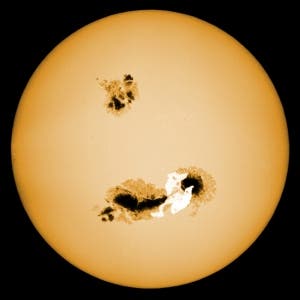Some stars, most often during their early life, exhibit an intense and energetic behavior, much greater than that of our own sun, despite a similar size, per say. In the first survey of its kind, scientists at Kyoto University have analyzed sun flares erupting on the surface of distant stars through out our galaxy. They found that some solar flares were even 10,000 times more powerful than those shot by the sun.

Just a few days ago, I wrote a bit on how solar flares and coronal mass ejections occur, and the impacts they might have on the Earth. The biggest concern involves electrical flooding of the grid after highly charged CMEs hit the Earth, which might cause severe damage to power lines, communication and GPS satellites and just about anything electronic; even if its unplugged (!). The largest recorded solar flare event occurred on 1 September 1859, and chance had it that British astronomer Richard Carrington was observing the sun right at the eruption moment, noting a great brightness as he was drawing sunspots for his sketches. Just hours later, when the eruption finally hit Earth, telegraph lines went down and flashed sparks even though batteries were disconnected. However, this paled in oddity compared to the massive aurora borealis which extended as far as the tropic at the event! It must had been a massive sun flare indeed, but considering the first electrically light city was still at least 20 years away, beyond the big scare and slew of superstitions unleashed, the event didn’t affect the life of human society at the time.
Were the Carrington event to happen today, things would’ve been a lot different. Imagine a world thrown in complete and utter pitch black darkness. Chaos. Now, imagine an event 10,000 times more powerful.
Some, maybe even more powerful, were observed by the Japanese scientists which analyzed four months worth of data delivered by the Kepler Telescope, directed towards a certain patch in the sky. The telescope’s main role is that of studying the slight shifts in brightness of stars, which might correspond to the moment an orbiting planet is passing in front of the sun, facing the observer. When you’ve got your “eye” right on the stars, it’s a pity actually not to dwell further deep and see what goes around beyond potentially orbiting exoplanets.
The Kyoto based researchers found that out of 83,000 stars of the same type as the Sun, 148 (about 0.2%) had superflares with energies between 10 and 10,000 times greater than the Carrington event. Most of the massive sun flares occurred on star which have a short period of ration, generally just 10 days, compared to a month required by the sun to make a complete revolution around its axis. Because these stars spin faster, they have more magnetic energy to burn, translating in more powerful eruptions.
Back to the Earth and massive solar flare hypothesis; a solar flare 10,000 times more powerful than those we’re currently experiencing nowadays would mean total annihilation of all life on Earth, instantly. The O-zone layer would simply shred to pieces, leaving way for massive amounts of radiation. But would the sun ever be capable of generating such an eruption. Scientists believe such an event is highly unlikely. All the massive solar flares were joined by giant sun spots, as well, a connection known for some time by scientists; these solar spots are a lot bigger than those usually surfaced on the sun. It still can fry all of our global electronics, though.
The findings were published in the journal Nature.



![An artist's conception of HD 209458 b, an exoplanet whose atmosphere is being torn off at more than 35,000 km/hour by the radiation of its close-by parent star. This hot Jupiter was the first alien world discovered via the transit method, and the first planet to have its atmosphere studied. [NASA/European Space Agency/Alfred Vidal-Madjar (Institut d'Astrophysique de Paris, CNRS)]](https://cdn.zmescience.com/wp-content/uploads/2020/11/247271_web-1-350x250.jpg)


